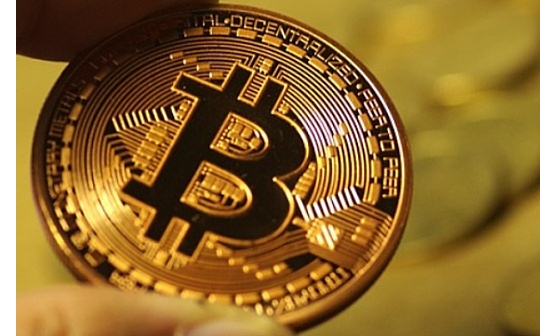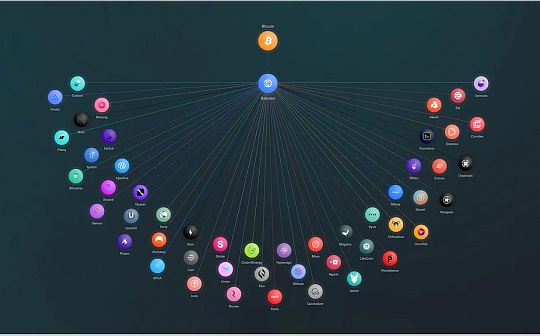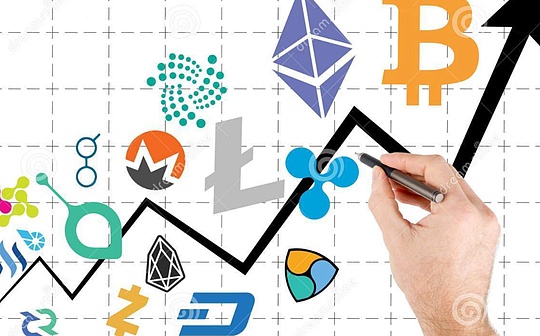BTC ecological process: asset issuance → expansion → interest generation/liquidity release

Reprinted from jinse
04/28/2025·14D**1. With the launch of Babylon and the opening of Lorenzo pledge, let’s
talk about the recent development of the BTC ecosystem.**
Since Ordi has made the BTC ecosystem popular, BTC has actually quickly compressed and taken the route ETH has taken - first to drive the chain assets (ERC20) - then to the expansion plan (Rollup) - and then to Staking/Restaking. But because there is no such decisive needle as ETHFoundation and V God to determine the direction, BTC is basically a situation where a hundred flowers are released at the same time.
The asset side first became popular with Ordinal, and then Brc20, Arc20, Src20, Orc20 and other XX20s were rushing out like crazy. Many people were happy last year that the BTC security model was expected to solve the problem (after 20 or 30 years, the block rewards can be as small as halving. There must be enough TX on the chain to pay the processing fee to miners). Last year, the processing fee was indeed more than the block reward. You can see that it is at most 300 BTC a day.
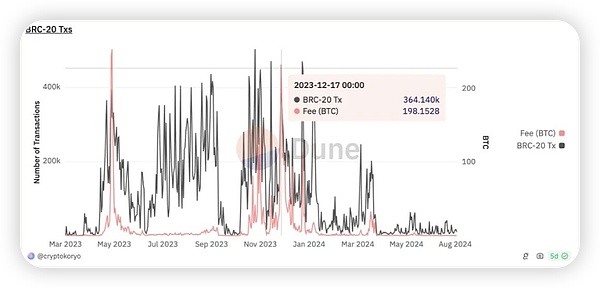
Look at August again... the BTC fee income is 0.00 per day. Rune was briefly popular in April and May, and then turned off the fire.
After completing ETH's ICO in 2017, we will follow the expansion plan represented by Merlin. We will first use ETH's EVM ready-made technology stack
- a multi-signal side chain to run first (by the way, Polygon - it was called Matic at the time and did the same thing)
Then, the expansion plan is much more than the Rollup set by ETH, which is officially set by ETH.
I simply drew a picture, basically this is what (the assets on the chain are also included and considered a technical branch)
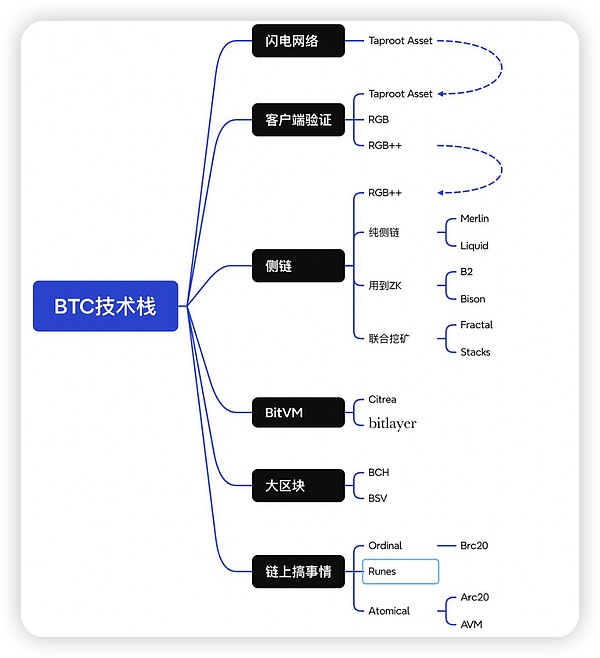
At present, Taproot Asset can only make money transfers. The most BTCNative (that is, based on the UTXO feature) is definitely RGB (can the main network no longer be delayed in September?), RGB++&UTXOStack, and Unisat's Fractal (there is a lot of calls recently)
In fact, there is a route missing in the picture, which is a contract virtual machine extension of layer 1.5, which means that it is undoubtedly ArchNetwork. The OP_NET I talked about recently is also considered, but Arch uses ZKVM, and OP_NET uses WASM
The expansion plan is because the technology stack is too messy and even more chaotic than assets, so it is hard to say who can come out in the end. We can only say that each has its own advantages and disadvantages, and leave it to time and the market. To put it in this direction, it may be impossible to completely falsify it in the end. After all, the current main narrative of BTC's "electronic gold" is actually not used to expand. Expansion is more for the purpose of "on-chain assets". If the route of on-chain assets does not start, expansion will naturally lose its meaning.
2. Finally, let’s talk about the third stage (Staking/Restaking)
This route is more Solid than the previous two routes, because it does not conflict with the electronic gold narrative at all, and is even a perfect supplement - releasing the liquidity of gold and turning gold into an interest-generating asset!
The most important project at this stage is undoubtedly Babylon, because BTC is not like Yield, which naturally has POS. Under the premise of Lido, EigenLayer's Restaking narrative is more like a Booster to ETH itself, or icing on the cake. Babylon is a timely help for BTC. By Trustless, BTC will be restaking and Yield will be generated. BTC will no longer be a "gold" with interest-free assets.
The other two are worth mentioning on this route. Solv and DLC.Link, the former gives BTC interest + SolVBTC liquidity through Cefi+Defi (one of the Babylon entrances). The latter uses DLC technology to mint dlcBTC, "Trustless Bridge" BTC to ETH, Solana and other chains to participate in the Defi ecosystem, which is convenient to understand and simply regard it as a decentralized and secure version of WBTC in the environment where WBTC is currently under the trust crisis.
Back to the topic, back to Babylon and Lorenzo, Babylon is undoubtedly targeting the ecological niche of EigenLayer, so there will naturally be asset entrances, that is, the ecological niche of LST/LRT is also extremely important. Etherfi, Renz0, Puffer, etc. On the Eigenlayer, there are also Solv, Lombard, and Lorenzo, among others.
The differentiation of each company is larger than that of several leading LRT projects on Eigen. For example, Solv has gained benefits in Cefi, including Babylon, and Defi, including BTC/ETH-related projects such as Ethena, Merlin, and Arb, and the second-tier cooperation benefits.
Lombard has an advantage in capital and intra-circle resources. At the same time, the LBTC it issues is also the most secure one. The CubeSigner (a professional non-managed key management platform) and Consortium (a consortium chain node network composed of industry leader nodes) are the most Balanced solutions I have seen in terms of security and flexibility.
Lorenzo directly integrates Pendle's principal and interest separation function, including the liquid staking token stBTC (each staking project is the same), and the liquid staking token YAT (each staking project is different). Lorenzo is also the only LST project on the market that provides users with YAT and points dual incentive system. The current total limit is 250BTC (to ensure user income), and there are still dozens of BTC capacity, which is expected to be full soon, first come first served.
Finally, compared with the two directions of asset issuance and expansion on the BTC chain, the interest generation/liquidity release of BTC is a more visible and tangible direction, which can also be seen from the layout of the A-Quan, especially the asset entrance. Among the projects mentioned above, Renzo, Puffer, Babylon, Solv, and Lorenzo Binance have investments, so you know, you have to stare at this track and pay attention to it!

